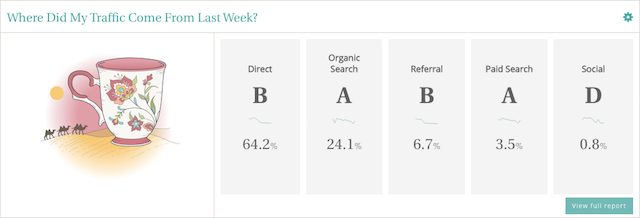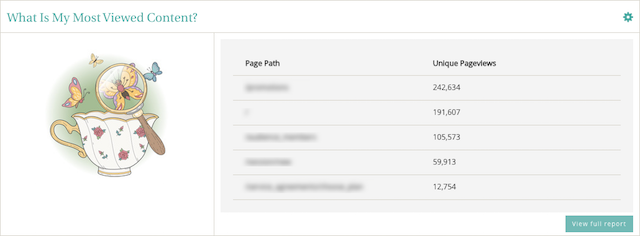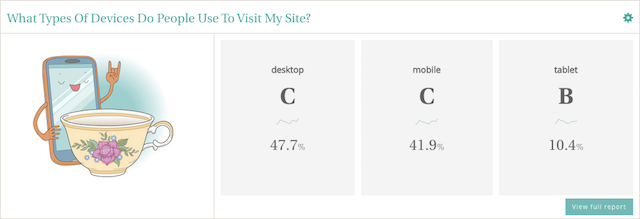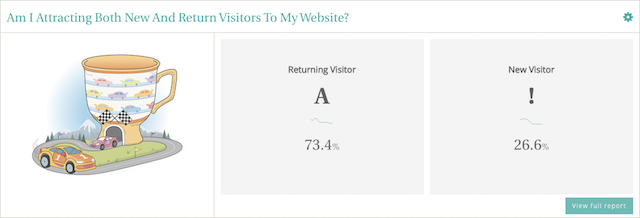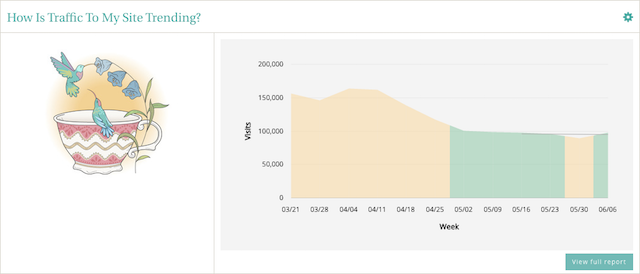“As an e-commerce business, we have a million decisions to make on our website like product curation, user experience, marketing, and more. Over the past few months I’ve realized how Google Analytics could help me see what customers are doing on my site, where they’re going, and where they’re getting stuck. It’s been incredibly helpful to help think through every element of our website’s design, content, product selection, and experience, knowing that there’s ways to verify some of the ideas we have about our website.” ~ Lawrence Clingman, Elementem Photography
I don't need to tell you how Google Analytics reports help your clients understand their audience. As web pros, you already know that. Sometimes, however, it's easy to forget that clients need more than just Google Analytics. They need you, too!
“When it comes to tracking the progress of my website, Google Analytics is a valuable resource. My web designer made sure that Google Analytics was on my site so I could track the important metrics each month.” ~ Sue Dunlevie, Successful Blogging
You don't solely design and develop websites. By choosing a professional to counsel them, clients expect more than they'd get from a turnkey, DIY platform.
Web professionals artfully craft the online experience, not just for your clients, but for your clients' customers. You provide expertise, direction, strategy, advice and occasionally reassurance.
Your clients need your help in making sense of their Google Analytics reports.
They expect reporting and analysis, and they'd like your help crafting a plan of action. Without your ongoing support, your clients might begin to feel that they're missing opportunities.
I spoke to more than 200 small businesses about Google Analytics, and these are the questions they'd most like the answers to.
What Google Analytics reports highlight traffic sources?
Small business owners often ask this question — and they love this first report. Being able to see the various channels that lead traffic to their site inexplicably causes the client brain to release endorphins. That's never a bad thing. But unless a report inspires action, it's quite useless. The Google Analytics Acquisition report offers mega value, making it the most important report of all:
Look at the channels that are performing well, as defined by lower bounce rates and higher conversion rates. When talking to clients, refer to these as "high-quality" channels. The key to remember is that they are ripe for growth.
Channels that have decent traffic but lousy conversion rates are ripe for optimization. These "low-quality" channels have leaks and need some attention.
If you notice that organic search is performing well, that's great! Maybe that indicates it's time to help your client develop a content marketing strategy. If you see they're getting no organic search traffic, it may mean it's time to optimize the site further for search engines.
The beauty here is that no matter what Google Analytics tells you, it always amounts to hard data telling your clients what they should be hiring you to do next.
Does your client have low-quality referral traffic? That's an opportunity. You can help your client filter out referral spam. Are they getting a significant amount of social media traffic with low conversions? That's another opportunity. You can help your client set up a strong call-to-action on their landing pages. See? If your head is in the game, acquisition reports just keep on giving.
You can make a beeline to this report over in the Google Analytics Solutions Gallery or in Teacup Analytics.
What’s my most popular content?
Why is the question of content popularity so darn popular? I’ll quote one of our customers:
"I want to learn what topics do best so that I can write more of them."
This makes sense. Your clients want to know how to attract more visitors to their site. It's up to you to help them understand the impact their content has on traffic. At first, this question might seem simple, but what makes content "popular?"
If popularity equates to "the most visitors," that's short-sighted. No one wants content to attract, say, a horde of zombies.
Content is best measured with engagement metrics.
Your client wants to know which topics attract visitors who explore, buy, or subscribe.
Find this Top Content report in the Google Analytics Solutions Gallery or Teacup Analytics.
Note: We've included a somewhat controversial metric in this report, Exit Rate. For many sites, exit rate reveals the spot where the visitor found what they needed. On other sites, it can show a problem page in need of serious attention.
How’s my mobile traffic?
You already know your client's site needs to be mobile-friendly, and that mobile traffic is probably a large percentage of their overall traffic. The Mobile Traffic report is a lot like the first report, except that traffic is coming from only mobile and tablet devices.
It uncovers opportunities for mobile optimization. With huge portion of the world using mobile devices to surf the web, this report pays off.
You can grab the Mobile Traffic report in the Google Analytics Solutions Gallery or Teacup Analytics.
Am I engaging with both new and returning users?
To better track and understand the growth of your clients' business, new web traffic is a big part of the story. The New vs. Return Traffic report helps you keep an eye on new traffic. More importantly, it helps clients understand the interplay between new and returning traffic. This subtle piece of info leads to all kinds of meaningful action and fantastic returns. That's why it's one of the most popular Google Analytics reports, and why people tend to look at it first.
The first thing I look for in this report is the trend of return visitors. Is the site attracting an ever-increasing number of return visitors? If so, it would be natural to assume that your client is turning new visitors into regulars.
The New vs. Return Traffic report acts as a bellwether.
This report also functions as a bellwether. If new visitors aren't converting, or they're not engaged while at the same time return visits are trending downwards, it indicates some issues with first impressions. Chances are it's time to work with your client to improve the new visitor experience.
The report offers the option to drill down into channels so you can see where the best performing new and returning visitors are coming from. It's a great way to budget time, effort and ad spend.
You can get the New vs. Return Traffic report in the Google Analytics Solutions Gallery or Teacup Analytics.
How’s my website traffic trending?
The Website Traffic report is more of a “starter” step. It can point you and your client down a path to deeper insights. It can answer the top-level question: where should I be digging deeper?
Technically, Google Analytics reports don't suit this type of question so you can simply use the first report again and extend the time period to three months or longer. In Teacup, you can find the report here.
Note the quality of your traffic by looking at bounce and conversion rates. Is your client's traffic growing and maintaining the quality, too? If so, celebrate! Clients love this report because it's a vanity metric. It means traffic is increasing, and that's always fun. But it's up to you to keep a cool head, act as the analyst, and tie traffic to conversions.
Analyze, act and measure
While these Google Analytics reports are great, don't bury your clients in reports. Chances are they don't want them all at once. Start with one or two. Act on the data for those, and measure the impact. As clients get used to making data-driven decisions, introduce more reports. If you get to the point where all of the big five up and running, your client's business will soar and so will yours.
Start simple, take an action, measure the results. You'll be a hero to your client. They'll be well informed, and their customers will have an easier path to the products and services they need. Everybody wins!

